Bettas belong to the murky tropical waters of Southeast Asia and love living in densely planted tanks.
Even though recreating an exact replica of their original habitat isn’t possible, you can use several live plants in your betta fish tank to make them feel at home.
But which are the best plants for betta fish? Do they love all live plants, or are there specific choices?
While there are a few favorites, bettas usually love almost all varieties of live plants. In this guide, I’ll take you through some of the best aquatic plants for betta fish they would love having in their aquarium.
Let’s begin.
Should You Use Real Plants Or Fake Plants In The Betta Tank?
Most aquarists prefer real plants for betta fish. Real plants are healthier for the fish and keep the tank clean. But since real plants need maintenance—and since keeping them alive is not everyone’s cup of tea—some betta fish owners want to know if they have the option to keep fake plants.
There are pros and cons of both real and fake aquarium plants. Let’s go through them:
Pros of real plants in a betta fish tank
- Real plants help maintain nitrite levels.
- Real plants balance the aquarium water parameters.
- They reduce the carbon dioxide levels in the water column.
- They imitate the thick vegetation of the natural environment.
- They don’t damage betta’s beautiful fins.
- They oxygenate the tank water.
Cons of real plants in a betta fish tank
- Real plants need regular maintenance.
- Real plants won’t survive if they fail to get enough light, nutrients, and other necessary factors.
- Some (not all) may induce pest growth.
Pros of plastic plants in a betta fish tank
- Artificial plants don’t have any special water requirements.
- They don’t lead to pest growth or have no risk of spreading diseases.
- There is a huge variety to choose from.
- They don’t require trimming or pruning.
- You don’t need to worry about keeping them alive.
Cons of fake plants in a betta fish tank
- They don’t help maintain the water chemistry.
- Fake plants don’t control nitrite growth.
- They don’t balance the carbon dioxide and oxygen levels in the water.
- The sharp edges of fake plants are harmful to the betta’s skin and fins.
- They may release chemicals into the tank.
As you can see, fake plants have greater disadvantages than they do benefits—especially considering they may harm your betta’s skin and fins. They are only for decorative purposes and do not help balance the aquarium environment. Live aquarium plants are clear winners between the two options.
30 Best Aquarium Plants For Betta Fish
Following are some of the best betta fish plants you can use in the tank to keep your fish happy and flourishing.
1. Java Fern

Java Ferns (scientific name Leptochilus Pteropus or Microsorum Pteropus) are a common pick among aquarists.
Java Fern is easier to maintain and can survive in low light and energy. It can easily adjust in water temperatures between 64 to 82 degrees Fahrenheit, which is similar to the preferred water temperature of betta fish.
The best thing is that Java Fern does not require CO2 to survive, so beginners won’t have difficulty keeping it a live.
Java Ferns are also inexpensive and are easy to find in most pet stores.
2. Amazon Sword
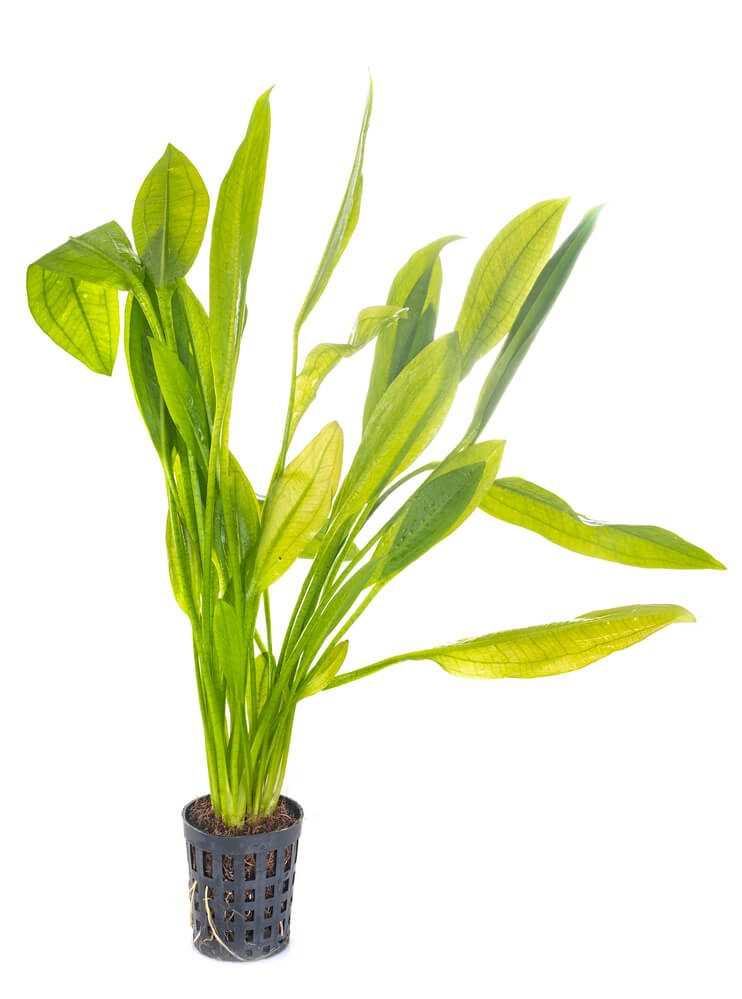
The scientific name of the Amazon Sword is Echinodorus Bleheri. It’s a tropical plant with broad leaves and it grows up to three feet tall. These baby sword plants are best suited for larger aquariums of ten gallons and more.
Compared to Java Ferns, the Amazon sword is a bit difficult to maintain. These plants need an additional supply of CO2 and plenty of sunlight. Therefore, this live plant is best for experienced aquarists.
While planting it, ensure you firmly anchor it using the aquarium substrates, otherwise, the water currents will uproot and damage the plant.
Bettas love Amazon Swords because its broad leaves work as excellent hiding spots. Additionally, bettas love resting on the plant’s wide leaves.
3. Cryptocoryne Wendtii
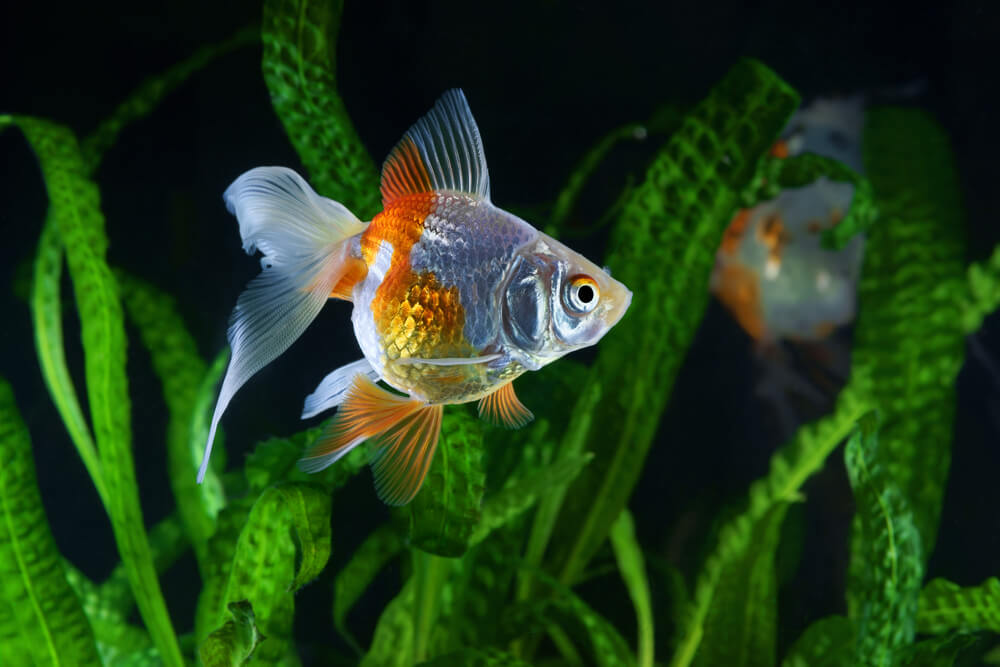
Cryptocoryne Wendtii is another beginner-friendly plant for betta keepers. The plant grows in both low and bright light, and keeping it alive won’t be an issue.
It’s a rooted plant that grows easily in betta aquariums. Propagating Cryptocoryne is also pretty simple—just cut newly grown plantlets and plant them in a new area. Being that Crytocoryne is so easy to propagate, you can have an endless supply of this plant in your tank!
Cryptocoryne is originally found in Asia and thrives in temperatures between 68 to 82 degrees Fahrenheit, perfect for your betta fish.
4. Anacharis (Brazilian Waterweed)
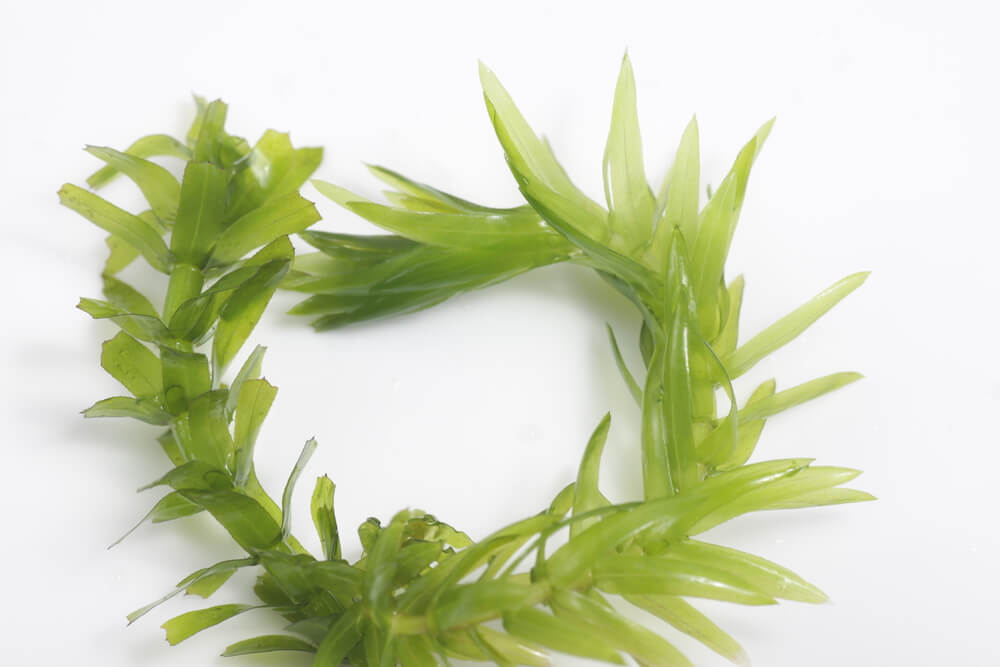
Anarcharis, or Brazilian Waterweed, is a great plant for betta fish tanks. The plant absorbs any toxins and filters out any toxins from the aquarium. Further, it sucks nitrite, thereby preventing algae growth.
It’s a vine-like plant that grows in heavy forests and is especially great for large betta tanks because it prevents light from peeking into the aquarium.
But Anarcharis needs some amount of maintenance, like CO2 fertilizer, which is why new aquarists might find it a bit difficult to maintain.
5. Java Moss

Java Moss grows at the bottom of the tank. Bettas love the soft velvety texture of Java Moss as it makes a great resting place for them.
Java Moss works great at covering sharp-edged aquarium substrates. This plant can grow under different lighting conditions, meaning you won’t need to run out and get a special light for it.
6. Anubias
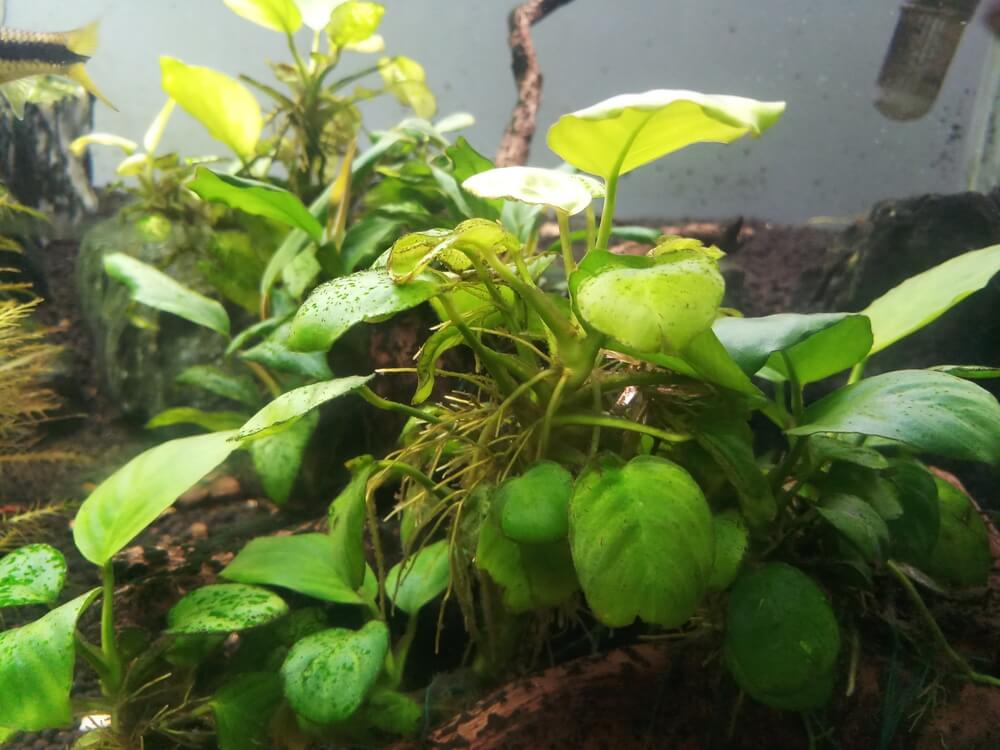
The next best plant for the betta tank is Anubias. Anubias plants grow in low light and have large thick non-toxic leaves.
It’s a slow-growing plant and takes its nutrients from the water. Since the plant grows best in low light, it’s best to keep it in indoor aquariums. Anubias needs periodic trimming otherwise due to its large leaves.
7. Glossostigma

Glossostigma is a Japanese-style plant originally found in Australasia. The plant grows naturally in ponds and lakes, and when planted in tanks, it brings a very aesthetic look to the aquarium.
Glossostigma is a very small plant that grows only a couple of inches tall. Even though it’s an excellent plant for a betta fish, growing it is a bit complicated.
The sole reason for the same is that bettas and Glossostigma have different lighting needs. While the betta fish loves a shady tank, Glossostigma needs bright light to grow.
Moreover, the plant grows upward instead of spreading horizontally. Hence, if you’re planting Glossostigma, you must ensure that other plants do not shadow it.
8. Pygmy Chain Sword Plant
Pygmy Chain Sword plant is a common pick among aquarists. They use it as a carpet plant in aquariums.
Growing Pygmy plants isn’t complicated. The plant can grow in a range of temperatures and pH levels, so it’ll also survive in the betta fish tank.
But to encourage growth, the Pygmy sword plant needs bright light. I would suggest keeping the betta fish tank near the window or near areas where it gets enough sunlight.
9. Hornwort

Hornwort is a great betta fish plant. Bettas love this bushy plant because it provides lots of hiding places, and the fish love to explore its branches.
Hornwort also keeps the aquarium water toxin free. Moreover, Hornwort can grow in both low and medium light, which matches the light requirement of betta fish.
Another plus point is that Hornwort can grow either as floating plants or can be planted in aquarium substrate.
But the only drawback is that Hornwort needs regular trimming. It’s a bushy plant; if not maintained, it will cover the whole tank.
10. Marimo Moss Ball
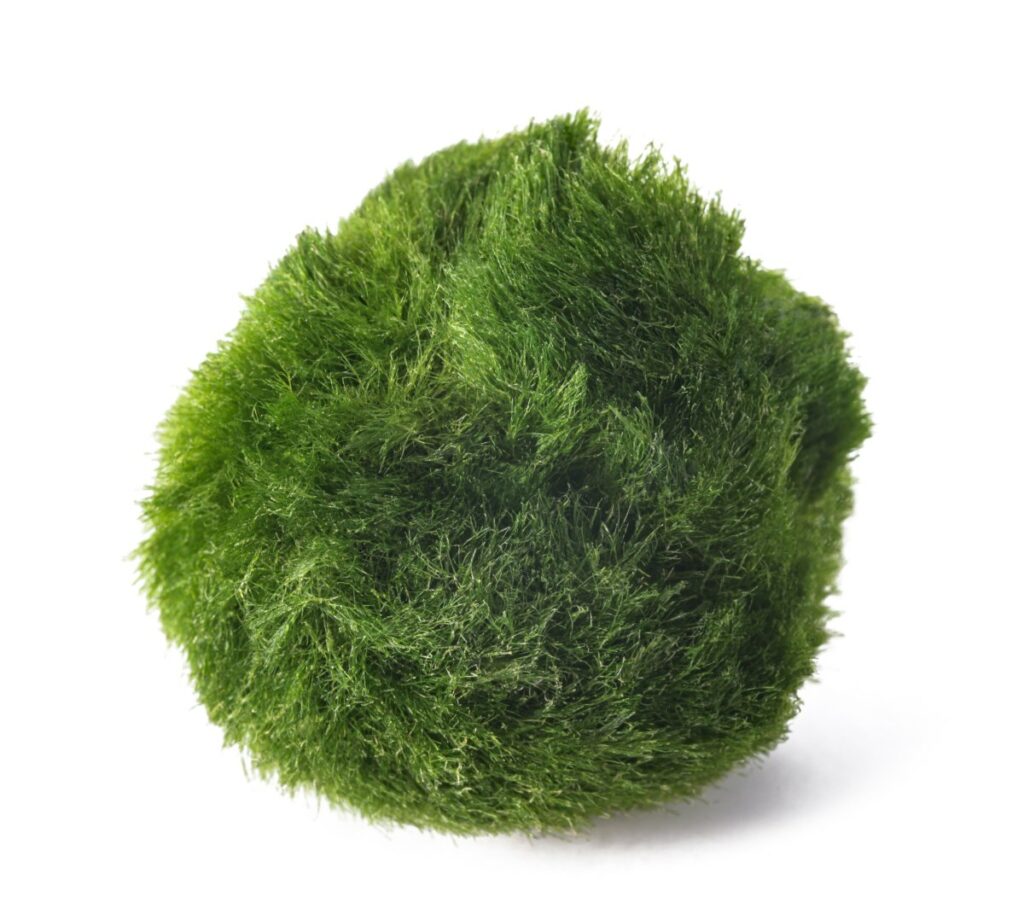
Bettas love the free-floating velvety squishy Marimo Moss balls. They use these balls as their resting spot and also love playing with them.
Marimo Moss balls are actually algae originally found in the lakes of Japan, where the continuous water currents give these balls a round shape. But the low current waters of betta fish tanks might flatten these balls. If you see the balls flattening, shake them a little to revive the shape.
To keep a Marimo Moss ball as healthy as possible, keep ammonia, nitrite, and nitrate levels as low as possible in your tank. It can also thrive in different water temperatures, but its preferred temperature is below 75 degrees Fahrenheit.
11. Bolbitis Difformis Baby Leaf Fern
Bolbitis Difformis are a subspecies of Dwarf fern. Also known as mini Bolbitis, these plants are originally found in the Philippines.
It can grow both submerged or immersed. The best way to grow mini Bolbitis is by attaching its roots to aquarium rocks or driftwood.
It’s a tiny plant that grows not more than three inches tall. Once it starts growing, it spreads to the bottom of the tank and forms a carpet.
Taking care of baby Bolbitis isn’t difficult. Just ensure the plant gets all essential nutrients and the aquarium water remains toxin-free.
12. Pennywort

Also known as Hydrocotyle Leucocephala or Brazilian Pennywort, this aquarium plant is popular among aquarists because of how easy it is to take care of it.
Pennywort requires very low light. The plant naturally gravitates to the water’s surface to soak up more light, growing an inch per week. Gradually, the plant creates a cover-up at the tank’s surface, making the tank environment similar to betta’s natural environment.
But as the plant grows so fast, it needs regular trimming. If you skip trimming the surface, it’ll smother the entire surface of the aquarium, making it difficult for bettas to breathe.
Surprisingly, Pennywort is an edible plant. It has a spicy note similar to the taste of black peppers.
13. Duckweed
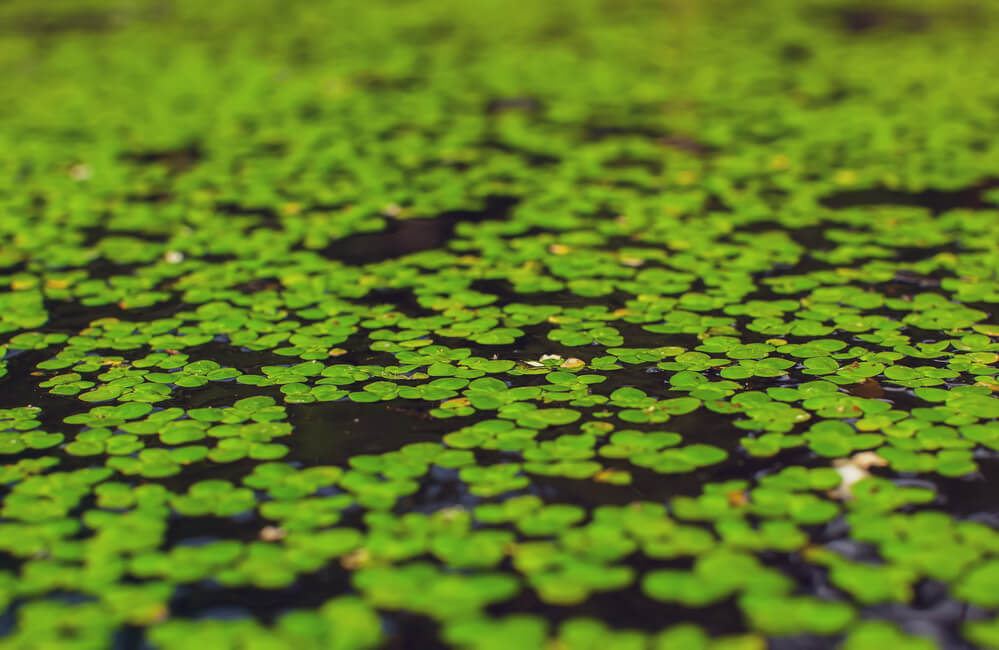
Duckweed is another different plant species bettas love. The plant is beneficial for the aquarium and soaks up any excess nutrients from the tank, however, it can also create some havoc.
Duckweed grows really fast, and once planted, it takes some work to maintain it. The plant can cover the entire tank, restricting the fish’s movement and also making it difficult to breathe.
Proper maintenance is a must to prevent the plant from covering the whole tank surface. You can use a plastic ring to corral the plant and prevent it from spreading in the aquarium.
14. Hygrophila
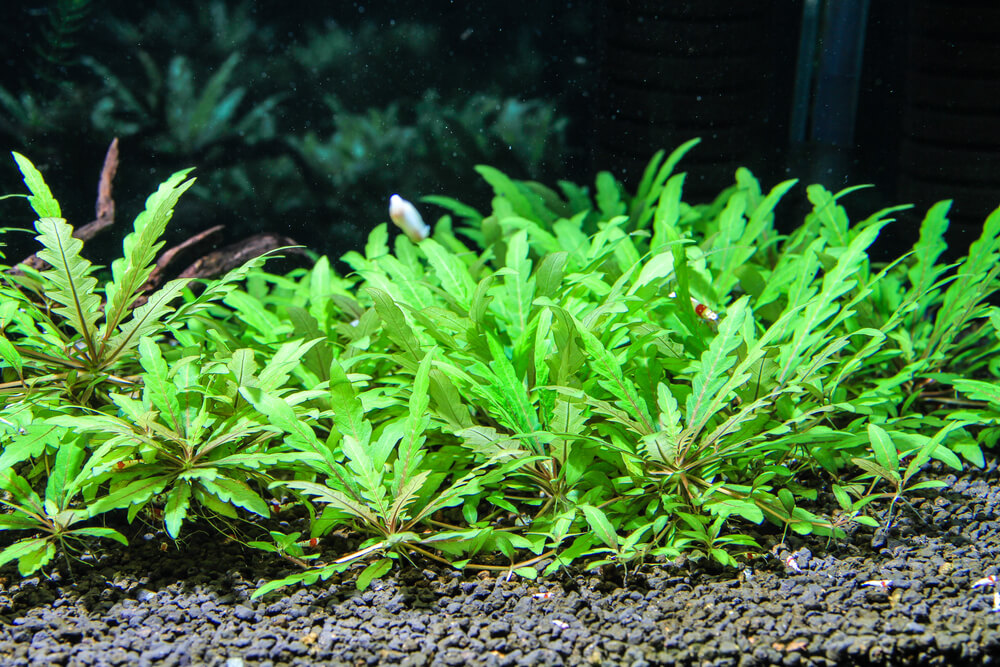
Hygrophila is a broad-leaf plant species. The plant can grow up to 28 inches tall and provides lots of hiding places for the betta fish.
But since the plant grows tall, it’s best suited for tanks bigger than twenty gallons. So, the plant is an excellent addition to community fish tanks.
Don’t plant Hygrophila in a small tank because it’ll soon cover the entire tank, blocking the breathing window for betta fish.
Hygrophila has two color variants: green and red. Both variants need a high level of light for healthy growth and to prevent the leaves from falling.
15. Bucephalandra
Also known as Buce, Bucephalandra is a new aquarium plant species. The plant wasn’t recognized as an aquarium plant until recent years and has quickly become a favorite among aquarists.
There are more than thirty Buce species, each with a unique leaf shape, color, and size. The plant is extremely easy to grow, making it best for novice aquarists too.
It’s a slow-growing plant, so it might take a few weeks or months to grow fully. The growth depends a lot on the amount of light it gets.
Buce needs more light, so to make it grow faster, you need to place the tank where it gets direct sunlight. Once grown completely, it reaches up to ten inches in height.
The only drawback is algae growth on the leaves. Therefore, you should keep algae eaters like Amano shrimp or nerite snails in the tank. As a bonus, both Amano shrimp and nerite snails make excellent tank mates for betta fish!
16. Water Sprite
Water Sprite is another easy-growing plant compatible with betta fish aquariums. Water Sprite is also known as the Indian Water Fern, Water Stag-Horn Fern, and Oriental Water Fern.
Water Sprite is originally found in Southeast Asia, India, East Africa, Northern Australia, and Central America.
Water Sprites grow very tall, but you can maintain their growth with frequent pruning. The plant also works as a natural filter keeping the aquarium water healthier for the fish.
Growing the plant won’t be a hassle because you can grow it both submerged or leave it floating on the top.
But allowing it to float won’t allow too much light to penetrate. Keep that in mind if you want to plant other plants at the tank bottom.
17. Amazon Frogbit

Amazon Frogbit is a dense plant that provides many hiding places for betta fish. It also creates the same dense environment bettas love.
Also, the fish loves to take refuge in the thick roots of the Amazon Frogbit. The plant also adds volume and diversity to the aquarium, making it look good.
Amazon Frogbit is easy to maintain, and the plant grows rapidly, so you’ll have to keep trimming and removing the excess from the tank. Make sure the plant is not placed near the tank filter, as filters can damage the plant.
18. Wisteria
Wisteria is a less popular plant in this list, but they are one of betta fish’s favorites. Wisteria is a unique plant that thrives when planted alone.
It can’t grow alongside most other recommended aquarium plants, which is why it is a rare choice among betta keepers.
But this versatile plant can take different shapes depending on the water condition, and bettas love hiding in its leaves.
Wisteria can grow both partially submerged and deep-rooted. Frequent trimming is required due to the fast growth of Wisteria.
19. Betta Bulbs
Betta Bulbs or Aponogenton is another very popular plant for betta aquariums. With its lush growth, the plant resembles the natural environment of betta fish and provides a lot of hiding and playing spots for the fish.
Betta Bulbs grow up to 12 inches tall, making them especially great for large aquariums. But if you maintain them, planting them in small aquariums shouldn’t be an issue.
Betta Bulb is also a fast-growing plant, and you need to trim it regularly.
20. Vallisneria
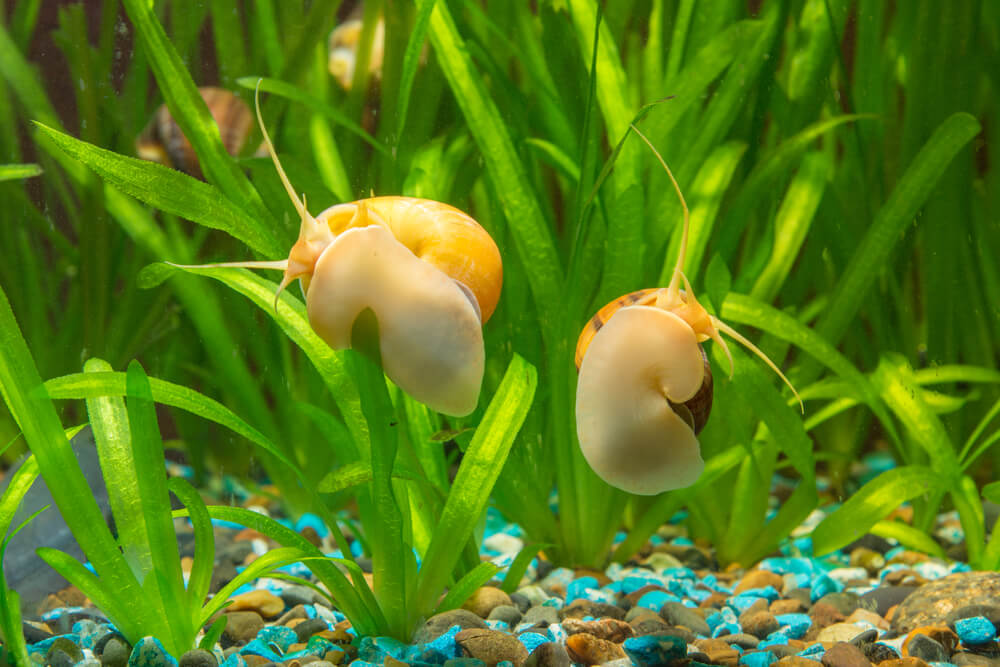
Vallisneria survives best in moderate to high light, however, it can survive in low light as well but will have slower growth.
The plant has a dense growth which provides lots of hiding places for the betta fish. But make sure not to bury the roots too deep as it may harm the plant’s health. Also, keep the plant’s crown exposed to the substrates for healthier growth.
21. Cryptocoryne Parva
Cryptocoryne Parva is the smallest plant in the Cryptocoryne family. The plant requires very little maintenance making it best for new aquarists as well.
Cryptocoryne has small leaves and grows only to a couple of inches. The small stature makes Cryptocoryne Parva the best plant for small tanks.
You can also use it as a carpet plant in large betta tanks. Nutrient-rich substrates, carbon dioxide injections, and water columns help aid in the healthier growth of the plant.
Even though Cryptocoryne prefers a well-lit aquarium, it can survive in low to medium light as well. However, the plant growth will be slowed down in lower light.
22. Alternanthera Rosaefolia
Alternanthera Rosaefolia is a plant from South Africa. The plant has long, pointed leaves with reddish-purple stems that look beautiful in the tank.
Regular nutrient supplements and CO2 injections are necessary to promote the healthier growth of the plant. One of the problems with planting Rosaefolia in the betta fish tanks is the difference in light requirement.
As you know, bettas prefer low-light tanks, but Rosaefolia plants need high lighting for proper growth. So the solution to that is to use the plant in shallow waters.
Regular pruning is necessary to encourage bushy growth instead of taller growth.
23. Marsilea Minuta

Water clover, or Marsilea Minuta, is an aquatic fern. It’s called Water clover due to the shape of its leaves. Marsilea Minuta is a popular pick among betta keepers because it’s so easy to take care of.
This slow-growing plant can survive in a wide range of water temperatures. But like Alternanthera Rosaefolia, Marsilea Minuta also needs more light.
If the plant does not get enough light, it’ll grow towards the aquarium surface more instead of spreading in the aquarium bottom.
24. Christmas Moss
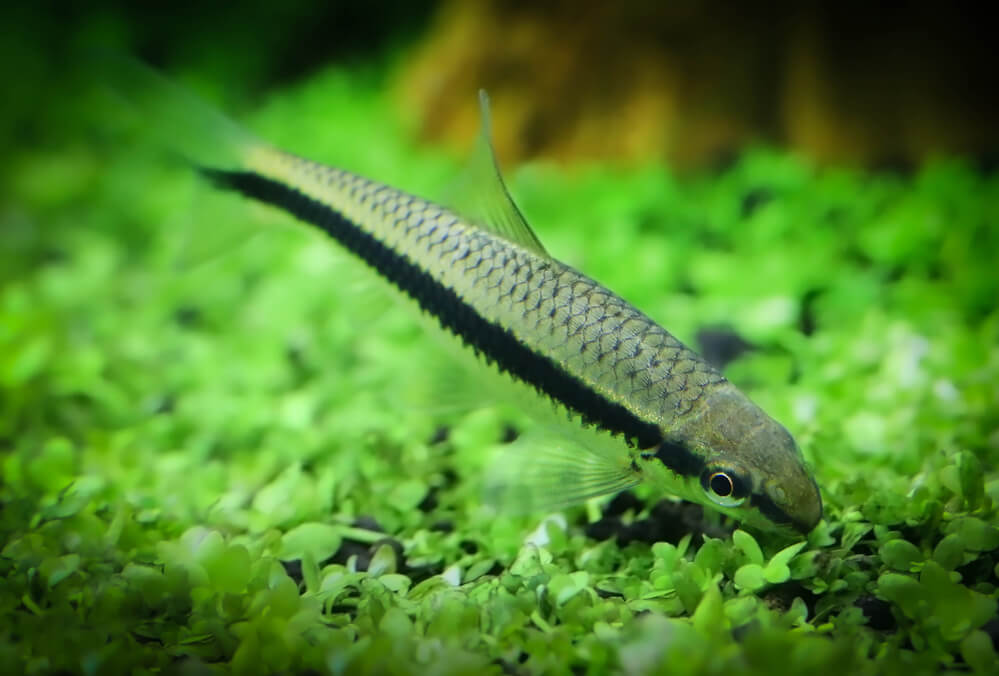
Christmas Moss is quite similar to Java moss. It’s a very hardy plant, hence can grow under various conditions.
The plant prefers moderate light levels but can also survive well in low light. Fortunately, Christmas moss needs the same water temperature as betta fish, making co-existing easier for both.
This type of moss grows fast, but it does not cover the whole tank. Instead, it grows in small bushy branches. The plant brings an aesthetic vibe to the fish tank with its lush green branches.
25. Anubias Nana
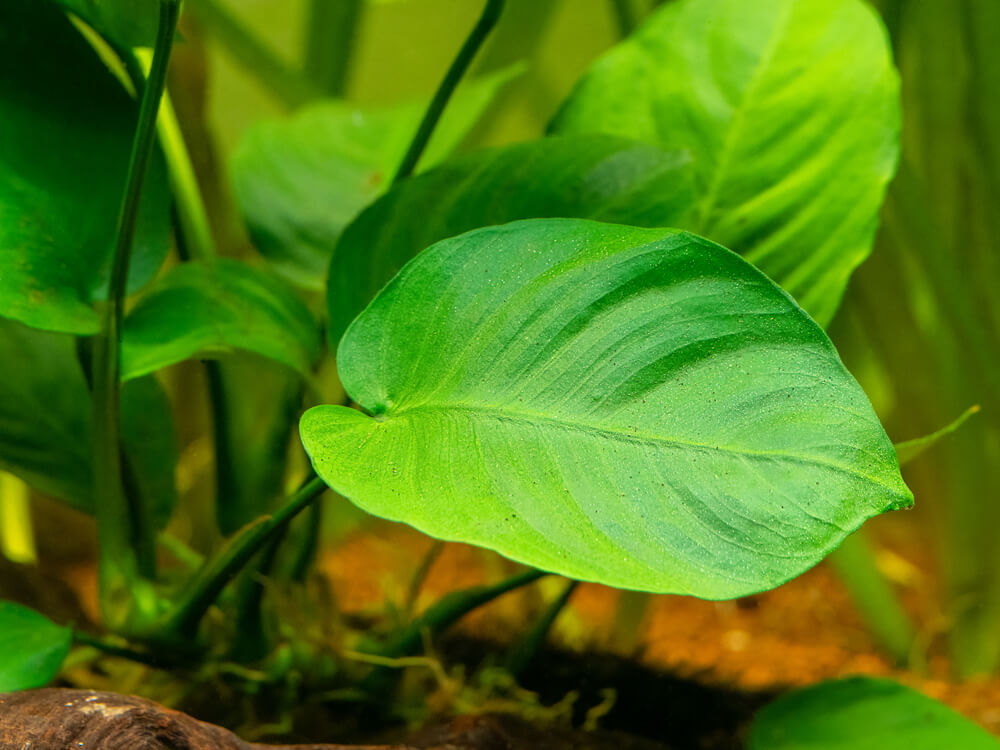
Another great live plant to add to the betta aquarium is Anubias Nana. The plant has small leaves and can grow well in low lighting.
This is a versatile aquarium plant that can attach to driftwood and other aquarium substrates. Also, the long wide leaves of Anubias work as a hammock for bettas.
If allowed, Anubias Nana can grow up to seven inches tall, making it suitable for large tanks. To keep Anubias Nana in small tanks, regular pruning, and trimming are a must.
The chance of fish eating the plant is also very less because bettas usually don’t like Anubias Nana leaves.
26. Anubias Barteri
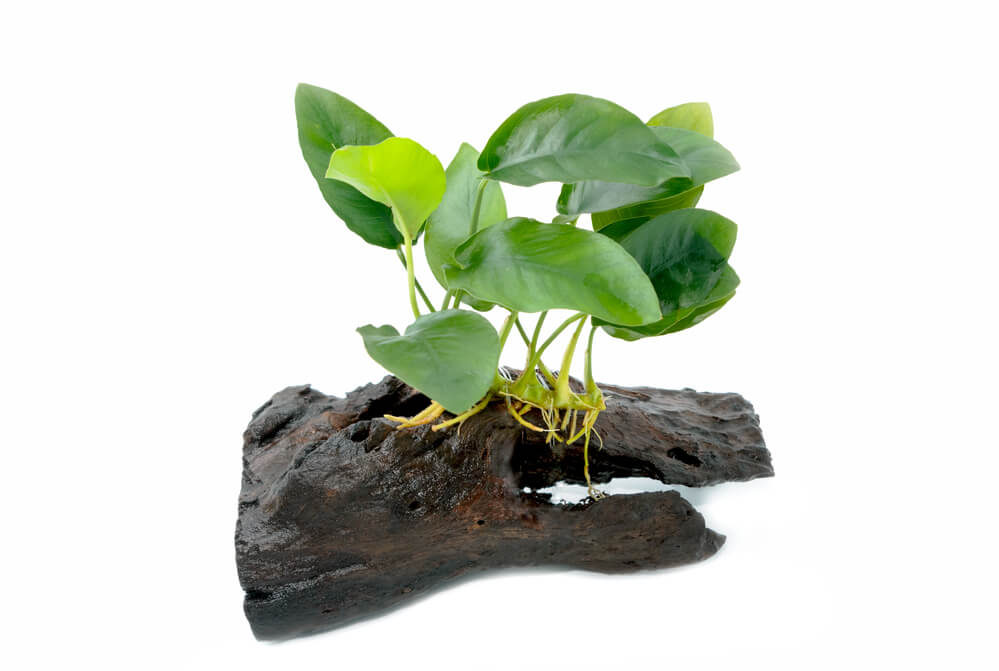
Anubia Barteri is a hardy aquarium plant that can survive in variable water conditions and lighting. The lazy bettas love resting on their leaves, another plus of planting Anubias Barteri in the betta fish tank.
While it’s a pretty easygoing plant, you must not bury it in the aquarium substrate. Doing so will make the root rot. The best way to plant these aquatic plants is to attach their roots to rocks or driftwood.
Please note that algae growth is an issue with this plant. To prevent algae growth, add a bunch of Amano shrimp to your tank. Bettas great along great with Amano shrimp, so you don’t need to worry about your betta feeling threatened alongside the shrimp.
Anubias Barteri can grow up to 18 to 24 inches tall. Regular pruning will keep the plant in shape.
27. Banana Plant
The banana plant is another common choice for freshwater tanks. The plant got its name from the swollen banana-shaped leaves.
The plant needs maximum light. Light also affects the color of the plant. Based on the amount of light it’s getting, its leaves can either be lime green to reddish purple.
Banana plants are not very finicky. The only thing you need to do is trim its leaves. If kept untrimmed, it’ll cover the entire tank surface.
28. Buchephalandra
New aquarists will find keeping Buchephalandra relatively easy. This Southeast Asian plant can be grown in shallow waters and can cope well with rocks and aquarium substrates.
These plants can be fully submerged or immersed, and their broad leaves offer the perfect resting spot for your lazy betta.
You’ll find Buchephaldra in a diverse range of colors and shapes, all of which are great for betta fish aquariums.
Propagating Buchephalandra is also easy. Simply cut the rhizome and tie it with a thread to the aquarium substrate or rocks.
29. Cryptocoryne Green Gecko
Cryptocoryne Green Gecko is a hardy plant that can survive in various water parameters and temperature levels.
This is also a broad-leaf plant with beautiful light green leaves, a reddish-brown patch at the center, and a red-brown midrib.
The plant will grow lush green if provided with the right lighting CO2 planted in rich soil. Other than these, there aren’t any strenuous care requirements.
Don’t worry if you don’t see very rapid growth. These Green Gecko varieties of Cryptocoryne plants grow slowly. The broad leaves of the plant make the perfect hammock for the betta fish, and your pet fish will love snoozing on them.
To propagate, simply snip off a few plantlets from the main plant and plant them into the aquarium soil.
30. Aponogeton Ulvaceus
Aponogeton Ulvaceus has light green translucent leaves and is a perfect addition to a betta fish tank.
The plant has very delicate spirals and grows up to an inch tall. You’ll usually find Aponogeton Ulvaceus in dried bulb forms, which makes growing the plant super easy.
All you have to do is bury it in the aquarium substrate, and you’ll notice it growing upward within a few days. Aponogeton Ulvaceus also comes in different colors, leaf shapes, and sizes, and the plant is originally found in Madagascar.
Things To Keep In Mind While Choosing Live Plants For Betta Fish
Keep in mind the following things while choosing plants for betta fish tanks:
Growth Rate
Different aquatic plants have different growth rates. Some are slow-growing plants, while others have fast growth.
Fast-growing plants are especially good for large tanks and will cover your tank quickly.
For small tanks, plants with a moderate growth rate are better. Otherwise, it’ll cover the entire surface, preventing light from coming in.
Whichever type you choose, make sure the plant gets enough light and necessary nutrients to promote healthy growth.
Light Requirement
The next important factor to consider is the light requirement. Bettas don’t like brightly-lit aquariums. and you need to look for plants that can survive well with low to moderate lighting.
Some aquarium plants need high lighting, like plants native to tropical areas. In contrast, plants native to colder weather require less lighting.
However, versatile plants can survive in low lights as well, but their growth slows down. The live plants I listed here are adaptable to any betta fish tank.
Water Flow
Bettas prefer slow-moving waters and you need to choose plants that do well with low-flow waters. If needed, you can add some floating plants to mitigate the water flow.
Root Feeders vs. Column Feeders
Another thing to consider while buying aquarium plants for your betta fish is whether they are root or column feeders. Root feeders take nutrients through their roots available in tank water.
Column feeders, on the other hand, take nutrients through the rhizomes from the water. Column feeders need to sit above the aquarium substrates so that rhizomes don’t get blocked and the plant receives a constant flow of nutrients.
3 Best Fake Plants For Betta Fish Tank
Although live plants are the best option for fish tanks, people with no time to care for them can use fake plants.
While buying fake plants, try getting soft silk plants. The soft edges of these plants won’t harm the fish’s skin, fins, and gills.
The following are a few great options for fake plants:
1. Marino Natural Silk Red Plant
Marino Natural Silk Red plant is an excellent addition to the betta tank. Usually, the plant measures up to six inches tall and adds a tinge of color to the aquarium.
The large long leaves of the silk red plant work as a great resting spot for the betta fish, and the soft edges keep the fish completely safe and sound.
2. Zoo Med Betta Hammock
It’s a single wide-leaf plant that you can easily keep in the aquarium. Also, the broad leaves work as a hammock for the fish, making it a great resting place.
Zoo Med Betta Hammock isn’t a silk plant, but it’s made from soft material that won’t damage the fish skin.
3. Blue Spotted Red Anubia Leaf For Betta Fish
This is another great fake plant for the betta fish. The aesthetically pleasing look of the Blue Spotted Anubia makes it a great addition to the betta tank.
Takeaway
That was an extensive list of the best plants for betta fish. The list includes plants for both beginner and experienced aquarists. As you can see, most plants need a moderate level of care, so maintaining them isn’t too difficult.
However, you must ensure that there isn’t a vast difference between the light, temperature, and pH requirements of the plants and betta fish. Otherwise, the plant won’t be able to survive.
I have also listed a few options for aquarists looking for fake plants. The artificial plants I listed are made from soft materials keeping in mind the safety of betta fish.
